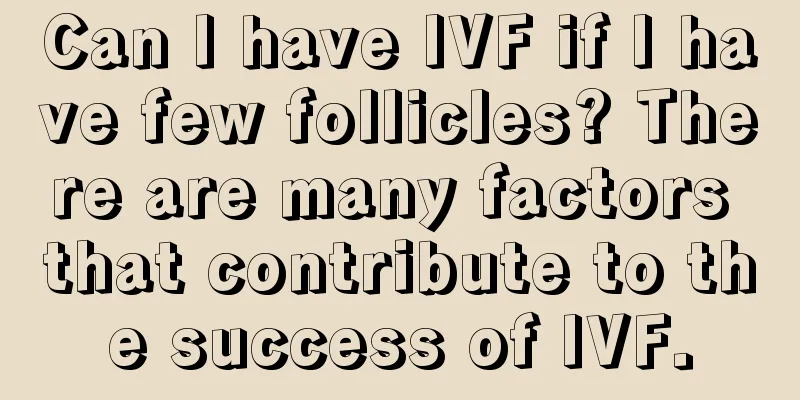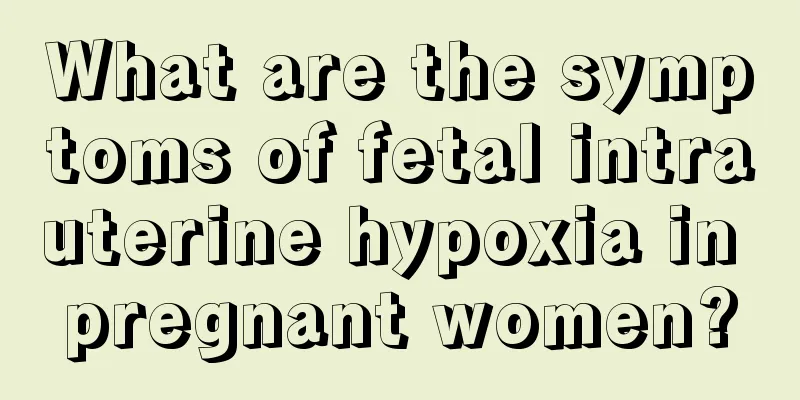Can I have IVF if I have few follicles? There are many factors that contribute to the success of IVF.

|
Nowadays, many families choose in vitro fertilization, especially now that the two-child policy has been relaxed. Many women want children but do not have the conditions to become pregnant. If they have few follicles, they can still have in vitro fertilization, because some drugs are used in the process of in vitro fertilization to promote the maturation of follicles. 1. Can I have IVF if I have few follicles? It can be done, but it will require some period of Chinese medicine conditioning in the early stages. Because in vitro fertilization uses hormonal drugs to stimulate the maturation of multiple follicles. As long as there are follicles, it can be done. The success rate depends on the quality of the eggs and the uterine environment. Generally, the medication is started in the mid-luteal phase, that is, on the 21st day of menstruation, to keep the gonadotropin level in the body at a low level. Menstruation will occur about 8 days after the medication. On the 3rd-7th day of menstruation, intramuscular injection of drugs that promote follicle development is started. After 3 days, B-ultrasound is used to monitor the development of follicles and adjust the dosage of the medication. Follicle-stimulating drugs are used for about 10 days. When the follicles are mature, the eggs can be removed by transvaginal vault puncture under the guidance of B-ultrasound, fertilized in vitro, and cultured for 3 days. The fertilized eggs develop into embryos and are placed in the uterine cavity. Rest in bed for 2-4 hours after transplantation. 2. Factors that affect the success rate of IVF: 1. Age is an important factor affecting the success rate of IVF. With age, the number of eggs decreases, the quality declines, the fertilization rate decreases, the pregnancy rate decreases significantly, and the miscarriage rate increases. The IVF pregnancy rate for women aged 41-42 is 12%, the live birth rate per transferred embryo for women over 42 is only 5.9%, and the miscarriage rate for women over 43 is as high as 50%. 2. Hydrosalpinx significantly reduces embryo implantation rate and pregnancy rate, reducing the pregnancy rate by 50%. Therefore, women with hydrosalpinx should have the hydrosalpinx removed before undergoing IVF. 3. Uterine abnormalities: Endometrial damage caused by endometrial polyps, endometritis, previous surgery or inflammation (tuberculosis is the most common) can affect embryo implantation. ... |
<<: Why is there infertility after removing the ring? Beware of these factors
>>: What are the side effects of the IUD?
Recommend
What is the cause of gynecological inflammation? There is water on the underwear
For women, if there is an increase in vaginal sec...
The reason why you can't touch raw water during confinement
Women consume more blood and qi after giving birt...
What should I pay attention to during a gynecological examination?
Nowadays, some diseases such as uterine fibroids,...
Elderly people suffer from chronic constipation? It turns out that calcium supplementation is to blame
As we age, the rate of calcium loss in the human ...
What to do if you have abdominal pain during your first menstrual period after curing your uterus
Uterine curettage is an artificial drainage surge...
Weight loss methods for middle-aged women
In life, many female friends will find that their...
How dirty are gyms? Here's one more reason not to go to the gym!
When you exercise in the gym, do you carry alcoho...
What to do if you fart in your vagina during sex
Many women will experience some embarrassing phen...
The leucorrhea has become a lump of glue
Women are like flowers, and flowers are like wome...
Fall prevention and health education for the elderly
As the population ages, the health and quality of...
How to reduce bleeding three days after abortion
Normally, women may have a small amount of bleedi...
Silver Age Health | What items should the elderly pay attention to in health checkups
Health check-up is an important means for the eld...
Can I still get the vaccine when I am four months pregnant?
The fetus is basically mature at four months of p...









